3.安裝webpack-html-plugin
4安裝vue
5安裝webpack-dev-server熱更新
6安裝babel
7安裝vue-loader處理vue的文件
8使用路由vue-router2
9.1vuex的基本應用
9.2state的拆分
10組件化,及組件間傳值
11.使用nodejs+koa2提供後台接口
12.設定koa允許前端跨域訪問
13 使用axios存取後台介面
git clone https://github.com/liubin915249126/vue2-study.git
cd vue2-study
安装cnpm镜像
npm install -g cnpm --registry=https://registry.npm.taobao.org
npm install //安装依赖包
npm start //启动项目
cd 'to/your/path' npm init
分為全域安裝和項目內安裝
npm install webpack -g
npm install webpack --save-dev
const path = require('path');
module.exports = {
entry: './Script/main.js', //项目入口文件
output:{ //输出编译后文件地址及文件名
path: path.resolve(__dirname, 'dist'),
filename: 'js/bundle.js'
}
};
命令列裡面執行webpack 指令即可看到編譯後的文件
npm install html-webpack-plugin --save-dev
const HtmlWebpackPlugin = require('html-webpack-plugin');
...
plugins:[
...
new HtmlWebpackPlugin({
title:'react 学习',
inject:'body',
filename:'index.html',
template:path.resolve(__dirname, "index.html")
}),
...
]
再次執行webpack指令可看到多了一個index.html檔案這個檔案是根據模板產生的並自動引入打包生成的js檔案運行打包後的index.html即可看到效果。
npm install vue -save
修改main.js:
import Vue from 'vue';
var MainCtrl = new Vue({
el:'#main',
data:{
message:'Hello world'
}
})
修改index.html:
<div id="main">
<h3>{{message}}</h3>
</div>
執行webpack打包運作index.html(打包的檔案)報錯,經查在webpack.config.js裡面設定:
...
resolve: { alias: { 'vue': 'vue/dist/vue.js' } }
再次運行即可看到效果
npm install webpack-dev-server -g
npm install webpack-dev-server --save-dev
npm install vue-hot-reload-api --save-dev
配置webpack.config.js
...
devServer: {
historyApiFallback: true,
},
...
配置package.json裡面指令
"start":"webpack-dev-server --hot --inline --progress --open"
執行npm start 瀏覽器自動開啟頁面,變更檔案後即可看到頁面即時更新
在使用.vue檔之前先安裝babel(將es6語法轉換為es5)
npm install babel-core babel-loader babel-plugin-transform-runtime --save-dev
npm install babel-preset-stage-0 babel-runtime babel-preset-es2015 --save-dev
專案根目錄新建.babelrc檔案、設定:
{
"presets": ["es2015", "stage-0"],
"plugins": ["transform-runtime"]
}
安裝loader 處理.css,.vue文件
npm install css-loader style-loader vue-loader vue-html-loader --save-dev
配置webpack.config.js
...
module:{
loaders: [
{test: /.js$/,loader: 'babel-loader',exclude: /node_modules/},
{test: /.vue$/,loader: 'vue-loader'}]
},
//vue: {loaders: {js: 'babel'}}
...
配置完運行報錯:Cannot find module 'vue-template-compiler' 安裝vue-template-compiler
cnpm install vue-template-compiler --save-dev
修改index.html:
<body>
<div id="main">
<app></app>
</div>
</body>
新建src/index.vue:
<template>
<div class="message">{{ msg }}</div>
</template>
<script>
export default {
data () {
return {
msg: 'Hello from vue-loader!'
}
}
}
</script>
<style>
.message {
color: blue;
}
</style>
修改main.js
...
import App from './src/index.vue';
new Vue({
el: '#main',
components: { App }
})
儲存後運行npm start 即可看到效果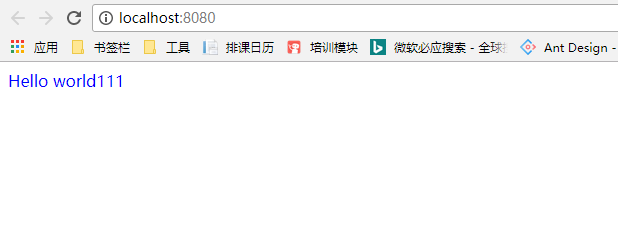
修改程式碼,可看到修改後的效果。
首先安裝vue-router:
npm install vue-router --save
修改main.js:
1.引入APP,about兩個元件導入router元件引入子元件Child
import App from './src/index.vue';
import About from './src/about.vue';
import Child from './src/children.vue'
import VueRouter from 'vue-router';
Vue.use(VueRouter)
2.定義路由: 嵌套路由用children:[]存放,子組件在父組件的
<router-view></router-view>
中渲染,路由透過"/:id" 定義參數透過連結"/about/123"傳遞參數在元件中透過{{$route.params.id}}取得傳參
const routes = [
{ path: '/index', component: App },
{ path: '/about/:id', component: About ,children:[
{ path: 'child', component: child}
]}
]
routes配置 const router = new VueRouter({
routes // (缩写)相当于 routes: routes
})
const app = new Vue({
router
}).$mount('#main')
5.修改index.html文件
<div id="main">
<p>
<router-link to="/index">index</router-link>
<router-link to="/about/123">about</router-link>
<router-link to="/about/123/child">child router</router-link>
</p>
<!-- 路由匹配到的组件将渲染在这里 -->
<router-view></router-view>
</div>
6.修改父元件about.vue 寫才發現,只能有一個頂層的HTML標籤
</template>
<div>
<div class="message">{{ msg }}</div>
<div>
<span>传递的参数为:{{ $route.params.id }}</span>
<router-view></router-view>
</div>
</div>
</template>
routes: [
...
{ path: '/a', redirect: '/index' }
]
訪問/a時將跳轉值/index對應的組件
用vue.js寫單頁面應用時,會出現打包後的JavaScript包非常大,影響頁面加載,我們可以利用路由的懶加載去優化這個問題。將路由寫法改為:
//定义路由
const routes = [
{ path: '/index', component: resolve => require(['./src/index.vue'], resolve) },
{
path: '/about/:id', component: resolve => require(['./src/about.vue'], resolve) ,
children:[
{ path: 'child', component: resolve => require(['./src/children.vue'], resolve)}
]},
{ path: '/a', redirect: '/index' }
]
// 字符串
router.push('home')
// 对象
router.push({ path: 'home' })
// 命名的路由
router.push({ name: 'user', params: { userId: 123 }})
// 带查询参数,变成 /register?plan=private
router.push({ path: 'register', query: { plan: 'private' }})
參考文獻:vue-router 效果圖: 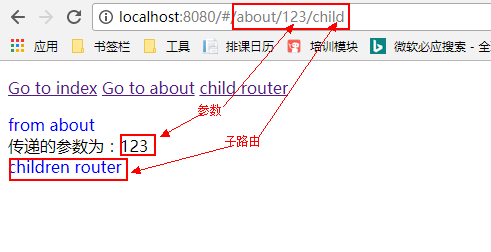
安裝vuex
npm install vuex --save
新建store.js檔:
import Vue from 'vue';
import Vuex from 'vuex';
Vue.use(Vuex)
//创建Store实例
const store = new Vuex.Store({
// 存储状态值
state: {
count:1
},
// 状态值的改变方法,操作状态值
// 提交mutations是更改Vuex状态的唯一方法
mutations: {
increment(state){
state.count++;
},
decrement(state){
state.count--;
}
},
// 在store中定义getters(可以认为是store的计算属性)。Getters接收state作为其第一个函数
getters: {
},
actions: {
}
})
// 要改变状态值只能通过提交mutations来完成
export default store;
在main.js裡面注入store;
...
//引入store
import store from './store.js'
...
const app = new Vue({
router,
store
}).$mount('#main')
新建count.vue文件,並新建路由指向count組件參考vue-router的使用。 count.vue檔案:
<template>
<div>
<div>{{$store.state.count}}</div>
<div>
<span @click="increment">increment</span>
<span @click="decrement">decrement</span>
</div>
</div>
</template>
<style>
</style>
<script>
export default {
data(){
return {};
},
methods:{
increment(){
this.$store.commit('increment')
},
decrement(){
this.$store.commit('decrement')
}
}
}
</script>
效果圖: 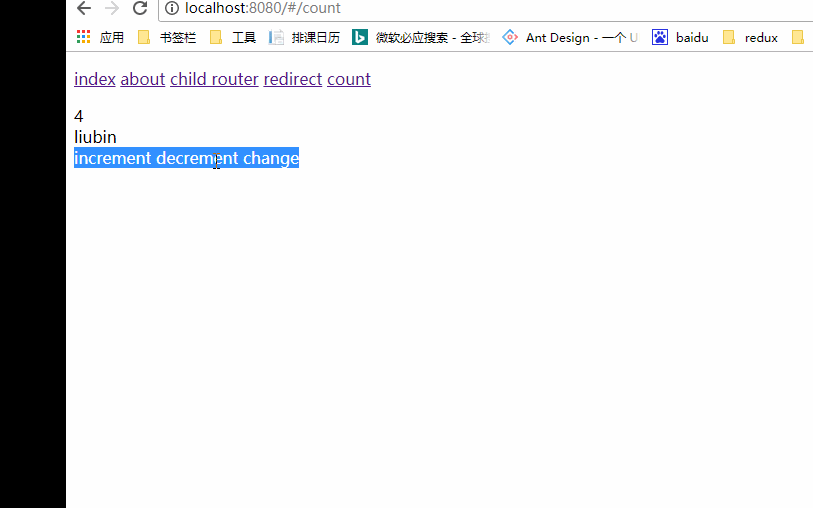
由於使用單一狀態樹,應用的所有狀態會集中到一個比較大的物件。當應用程式變得非常複雜時,store 物件就有可能變得相當臃腫。 為了解決以上問題,Vuex 讓我們可以將store 分割成模組(module)。每個模組擁有自己的state、mutation、action、getter
新建moduleA.js,moduleB.js
並修改store.js:
...
import moduleA from './moduleA';
import moduleB from './moduleB';
...
Vue.use(Vuex)
//创建Store实例
const store = new Vuex.Store({
modules:{
moduleA, moduleB //es6的写法,合并模块
}
})
...
在組件裡面想訪問到state需要用到
$store.state.moduleA.count
$store.state.moduleB.Name
效果圖: 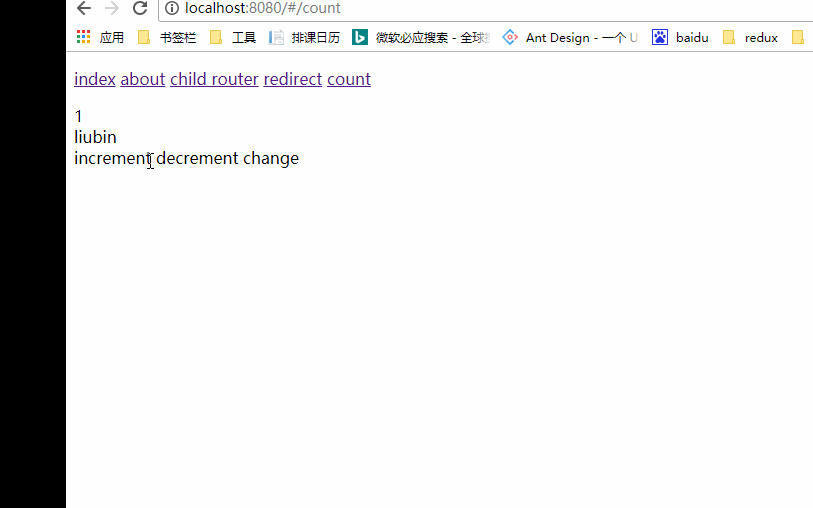 mutations裡面修改state的方法依然不變
mutations裡面修改state的方法依然不變
元件(Component) 是Vue.js 最強大的功能之一。元件可以擴充HTML 元素,封裝可重複使用的程式碼。在較高層面上,元件是自訂元素,Vue.js 的編譯器為它添加特殊功能。在某些情況下,元件也可以表現為以is 特性進行了擴充的原生HTML 元素。
組件A寫法:
<template>
<div class="componentA">
...
</div>
</template>
<script>
export default {
data () {
return {
msg: 'component-A',
}
}
}
</script>
<style>
</style>
組件B寫法:
<template>
<div class="message" id="componentB">
...
</div>
</template>
<script>
import Vue from 'vue'
export default Vue.component('my-component', {
template: '#componentB ',
data(){
return {
msg: 'component-B',
}
}
})
</script>
<style>
</style>
在父元件component 分別引用掛在
<template>
<div>
<component-A ></component-A>
<component-B></component-B>
</div>
</template>
<script>
import componentA from './component-a.vue';
import componentB from './component-b.vue'
export default {
data () {
return {
}
},
components:{
"component-A":componentA,
"component-B":componentB
}
}
</script>
<style>
</style>
對於簡單的父子組件或是同屬同一父組件的兄弟組件之間的通信,vue提供了方法,沒必要用到vuex
父組件:
<component-A :logo="logoMsg"></component-A> //logoMsg是父组件data里的值
子組件:
<template>
<div class="componentA">
<div>{{logo}}</div>
</div>
</template>
...
data(){
}
props:["logo"],
...
父組件:
<component-A :logo="logoMsg" @toParent="componenta"></component-A>
...
methods:{
componenta:function(data){ //data就是子组件传递过来的值
this.data1 = data
}
}
子組件:
methods:{
toParent:function(){
this.$emit('toParent',this.data1) //调用父组件toParent方法,并传递参数
}
}
效果圖: 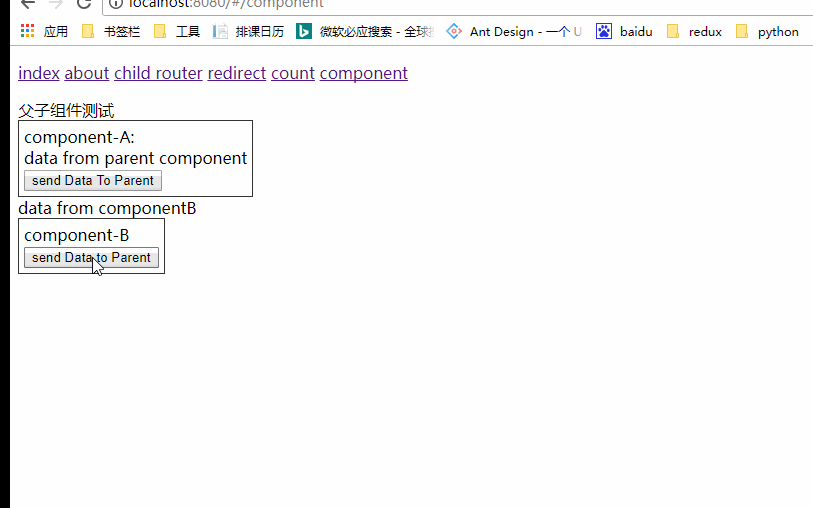
效果圖: 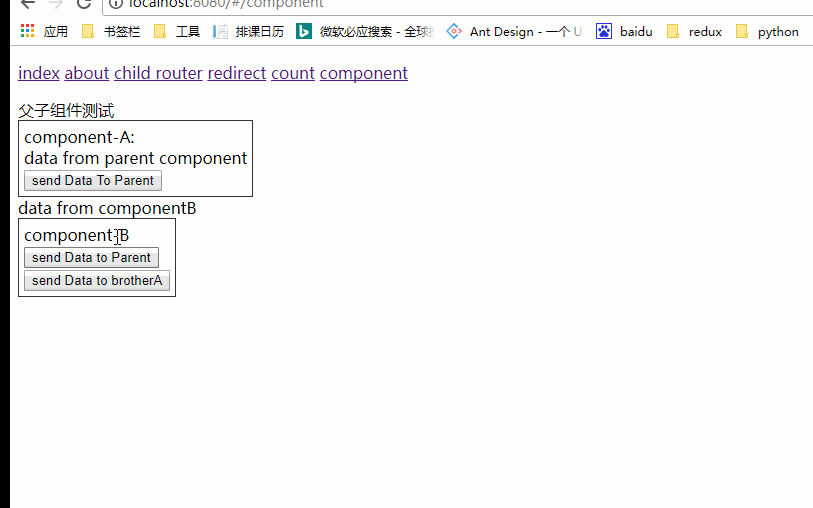
bus.js檔:
import Vue from 'vue'
export default new Vue()
組件B $emit觸發事件:
import Bus from './bus.js'
...
byBus:function(){
Bus.$emit('byBus',this.byBusData)
}
元件A $on接受事件傳遞數據
...
data(){
},
created(){
Bus.$on('byBus',(data)=>{
this.busData = data
})
},
效果圖: 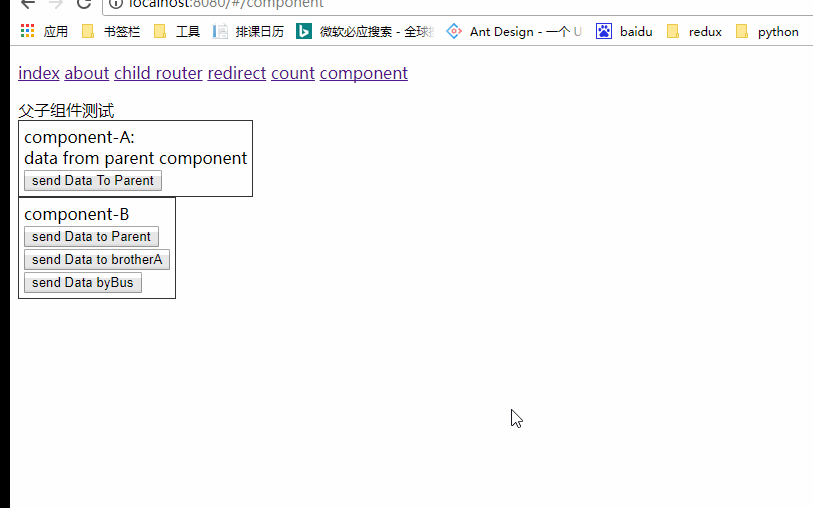
npm install koa koa-router --save-dev
在根目錄下下新server/index.js檔index.js:
const Koa = require('koa');
const router = require('koa-router')();
const app = new Koa();
router.get('/', (ctx, next)=> {
ctx.response.body = '111'
});
app
.use(router.routes())
.use(router.allowedMethods());
app.listen(3000,()=>{
console.log('server is start at port 3000')
});
package.json裡面設定指令:"server":"node server index.js" 啟動服務:npm run server 瀏覽器裡面存取localhost/3000可看到回傳值
使用koa2-cors設定跨網域安裝npm install koa2-cors --save-dev
...
app.use(cors({
origin: function (ctx) {
if (ctx.url === '/test') {
return false;
}
return '*';
},
exposeHeaders: ['WWW-Authenticate', 'Server-Authorization'],
maxAge: 5,
credentials: true,
allowMethods: ['GET', 'POST', 'DELETE'],
allowHeaders: ['Content-Type', 'Authorization', 'Accept'],
}));
...
安裝axios:
npm install axios --save
在根目錄新建server/request.js 封裝一個request函數,所有的請求都透過request函數,便於對於請求統一處理
import axios from 'axios'
let BASE_URL = 'http1://localhost:3000'
export default function request(data){
let options = {...data}
options.url = `${BASE_URL}${data.url}`
return axios(options)
.then(checkStatus)
.then(parseJSON)
.catch()
}
(坑)axios.defaults.withCredentials = "include" //請求時帶上cookie axios請求預設是不加cookie的需要設定(坑)當設定請求時帶上cookie時後端允許的跨域不能用"* "要說明協定+網域+連接埠請求資料效果圖:效果圖
安裝:npm i element-ui -S 引入:
import ElementUI from 'element-ui'
import 'element-ui/lib/theme-default/index.css'
Vue.use(ElementUI)
使用:使用前設定css,file載入器安裝style-loader,css-loader
npm install css-loader style-loader file-loader --save-dev
{
test: /.css$/,
loader: 'style-loader!css-loader'
},
{
test: /.(eot|svg|ttf|woff|woff2)(?S*)?$/,
loader: 'file-loader'
},
{
test: /.(png|jpe?g|gif|svg)(?S*)?$/,
loader: 'file-loader',
query: {
name: '[name].[ext]?[hash]'
}
}
安裝:
cnpm install less less-loader --save-dev
使用:
<style lang='less'>
.articleWrap{
.articleTop{
color:red;
}
}
</style>
1.路由跳轉傳參:
<router-link :to="{ name:'articleinfo',params:{id:index}}"></router-link>
2.使用富文本編輯器:vue2-editor 安裝:cnpm install vue2-editor --save 使用:import { VueEditor } from 'vue2-editor'
使用cross-env:設定開發環境安裝:cnpm install cross-env --save-dev 設定指令:
"start": "cross-env NODE_ENV=development webpack-dev-server --hot --inline --progress --open",
"build":"cross-env NODE_ENV=production webpack"
修改webpack配置:
if (process.env.NODE_ENV === 'production') {
config.plugins = (config.plugins || []).concat([
new webpack.DefinePlugin({
'process.env': {
'NODE_ENV': JSON.stringify('production'),
},
IS_PRODUCTION: true
}),
/*new webpack.optimize.UglifyJsPlugin({
compress: {warnings: false},
sourceMap: false
}),*/
]);
}
else {
config.plugins = (config.plugins || []).concat([
new webpack.DefinePlugin({
'process.env':
{
'NODE_ENV': JSON.stringify('development'),
},
IS_PRODUCTION: false
}),
]);
}
在程式裡面透過:process.env.NODE_ENV 取得目前環境變數